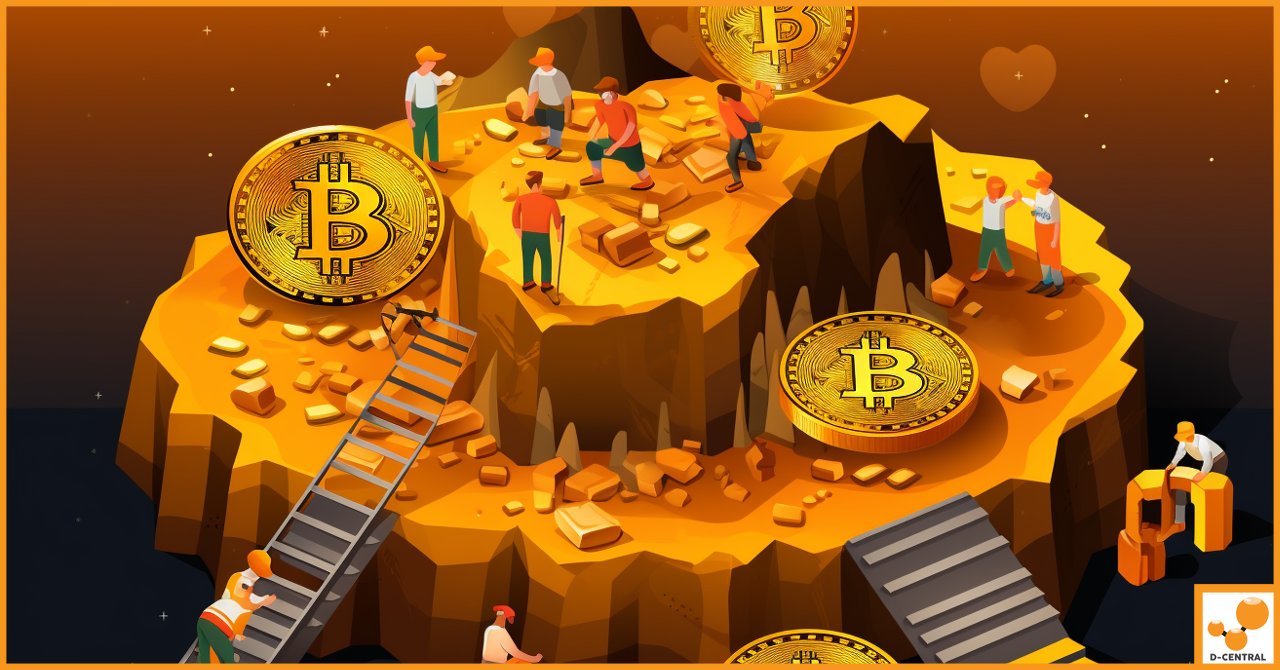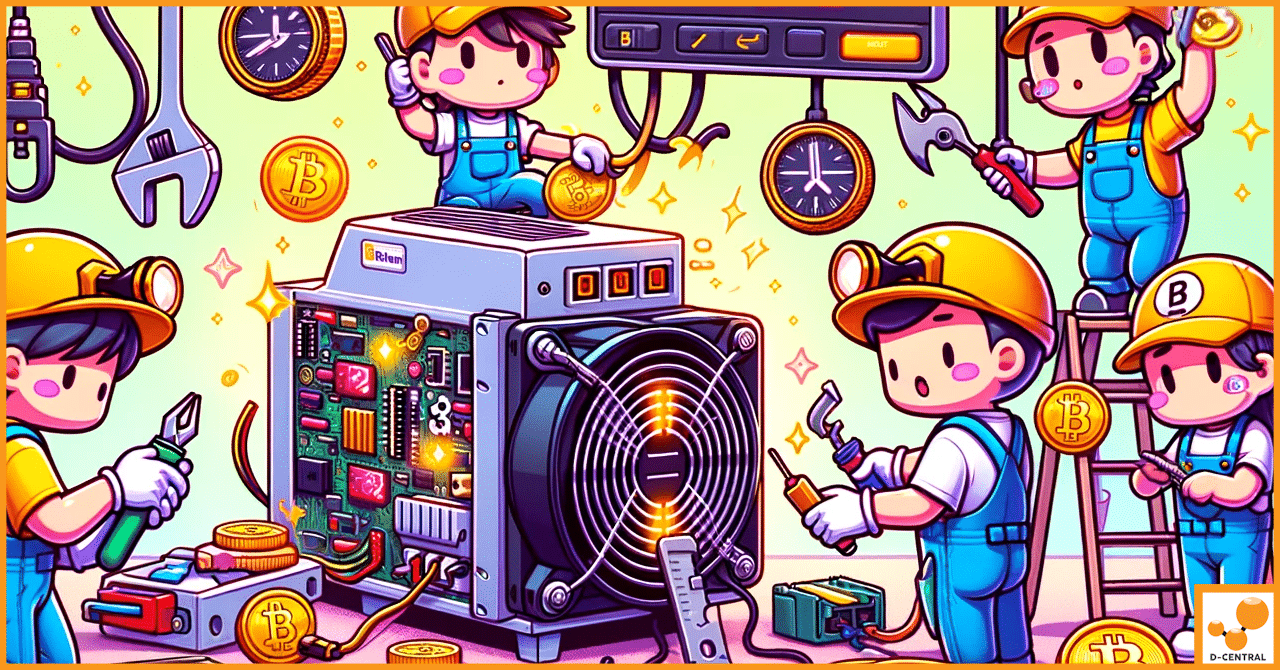
Bitcoin Mining Fees Explained: A Comprehensive Guide
In the dynamic world of cryptocurrencies, Bitcoin stands as a pioneering force, reshaping our understanding of digital finance. At the
4479 Desserte Nord Autoroute 440, Laval, QC H7P 6E2

As Bitcoin continues to gain mainstream acceptance, the spotlight increasingly falls on the mining sector. Mining, the backbone of the Bitcoin network, has evolved significantly since Bitcoin’s inception. While it started as a decentralized endeavour accessible to anyone with a computer, it has increasingly become centralized. Large mining pools and organizations now dominate the landscape, raising concerns about the network’s resilience and security.
In response to this centralization, two revolutionary concepts have emerged: Pleb Mining and StratumV2. Pleb Mining is the idea that everyday individuals, or “plebs,” can and should participate in Bitcoin mining. It’s a grassroots movement aimed at redistributing mining power back to the individual. StratumV2, on the other hand, is a protocol upgrade designed to give miners more control over the transactions they include in new blocks, reducing the influence of centralized mining pools.
Decentralization is not just a buzzword; it’s the cornerstone of Bitcoin’s security and resilience. A decentralized network is less susceptible to attacks, censorship, and manipulation. As Bitcoin continues to challenge traditional financial systems, maintaining its decentralized nature becomes increasingly critical. This is where Pleb Mining and StratumV2 come into play.
The future of Bitcoin hinges on its ability to remain decentralized and secure. Pleb Mining and StratumV2 are not just innovative ideas; they are essential mechanisms for achieving these goals. By empowering individual miners and reducing the influence of large mining pools, these initiatives pave the way for a more democratic, resilient, and secure Bitcoin network.
Drivechains are a hot topic in the Bitcoin community, offering a way to implement sidechains that are pegged to the Bitcoin blockchain. These sidechains allow for experimentation and the addition of new features without affecting the main Bitcoin network. The concept holds significant promise for scalability and the introduction of new functionalities. However, it also raises questions about security and the potential for centralization.
While the debate around Drivechains is undoubtedly important, we at D-Central believe there are more pressing issues that require immediate attention. Specifically, we are focusing on the centralization of mining power in the hands of a few large organizations. This centralization poses a direct threat to the Bitcoin network’s integrity and security. Our efforts are currently directed towards promoting Pleb Mining and the implementation of StratumV2, as we see these as critical steps towards decentralizing mining power and strengthening the network. Additionally, we are deeply committed to the deployment and development of open-source solutions at every layer of Bitcoin mining, from the hardware to the code running it.
One of the most concerning risks of mining centralization is the potential for transaction censorship. When a small number of large pools control the majority of the network’s mining power, they have the ability to selectively include or exclude transactions from blocks. This concentration of power undermines the core principles of openness and neutrality that Bitcoin was built upon. It also makes the network more vulnerable to external pressures from governments or large corporations that may seek to influence these mining pools.
In essence, our multi-faceted approach targets the root causes of centralization and vulnerability in the Bitcoin network. Through Pleb Mining, StratumV2, and open-source initiatives, we are laying the groundwork for a more decentralized, secure, and robust Bitcoin ecosystem.
StratumV2’s journey began under the name BetterHash, a protocol designed to address the limitations of its predecessor, Stratum. The original Stratum protocol was efficient but lacked features that could empower individual miners. BetterHash aimed to rectify this by offering a more decentralized approach to mining. Over time, BetterHash evolved into what we now know as StratumV2, a comprehensive upgrade that not only decentralizes mining but also enhances efficiency and security.
StratumV2 is revolutionary in how it shifts the balance of power back to individual miners. Unlike its predecessor, StratumV2 allows miners to construct their own block templates. This means that miners have greater control over which transactions get included in new blocks, reducing the influence of centralized mining pools. By giving miners more autonomy, StratumV2 aligns with the core principles of Bitcoin, promoting a more decentralized and democratic mining process.
The real-world implications of StratumV2 are profound. Here are some key benefits:
StratumV2 is more than just an upgrade; it’s a paradigm shift in how Bitcoin mining can function. By empowering individual miners and reducing centralization, StratumV2 is setting the stage for a more secure and efficient Bitcoin network.
https://twitter.com/DCentralTech/status/1696930340785246402
While economic incentives are a significant driver for Pleb Mining, the ideological aspects cannot be ignored. For many, the act of mining is a form of participation in a financial revolution. It’s a statement against centralized financial systems and a step towards a more democratic and equitable world. With hardware like Bitaxe or Bitaxe Ultra, individual miners can point their efforts towards a solo pool or even their own node, making the mining process deeply personal and ideologically fulfilling.
StratumV2 amplifies the power of Pleb Mining by allowing miners to create custom block templates. This means that individual miners have a say in which transactions get included in new blocks, thereby contributing to the decentralization and security of the network. StratumV2 is not just a protocol; it’s a tool for empowerment.
Imagine a world where the majority of the corporate hashrate is compromised in some form, leading to transaction censorship. In such a scenario, the power of Pleb Mining becomes evident. Even if just one chip in a Bitaxe or Bitaxe Ultra setup finds a valid block, it can include all the transactions that were being censored. This block, if it becomes part of the longest chain, forces the compromised entities to make a choice: either try to outpace the network by finding two blocks in quick succession or accept the valid block and build upon it. The latter is the most likely scenario, thereby breaking the censorship attempt.
Bitaxe and Bitaxe Ultra are designed to make mining accessible to everyone. Consuming less than 15 watts, these chips can be run in any home, making it feasible for millions to participate in Pleb Mining. The sheer number of individual miners would serve as a bulwark against any attempts at centralization or censorship.
While the economic incentives, especially in colder climates, make Pleb Mining an attractive option, the ideological incentives and the potential for widespread censorship resistance make it a necessity. StratumV2 and hardware like Bitaxe and Bitaxe Ultra are not just facilitating this movement; they are accelerating it. In a world where the principles of decentralization and individual empowerment are often at risk, Pleb Mining stands as both a safeguard and a statement.
Step in the right direction but the real solution is millions of individual miners instead of a few hundred mega mines…
— John S (@JStefanop1) August 26, 2023
Over the past few years, we’ve witnessed a significant shift in Bitcoin’s hashrate distribution. Once dominated by China, the majority of mining power has now moved to the United States. While this geographical shift has diversified the mining landscape to some extent, it has also introduced new challenges and risks.
The concentration of hashrate in the U.S. poses a different set of risks, primarily because it is increasingly in the hands of a few large, publicly traded entities. These organizations are susceptible to regulatory pressures and could be “choked into compliance,” thereby posing a risk to the decentralized nature of Bitcoin. Moreover, geographical concentration makes the network vulnerable to localized disruptions, be it regulatory clampdowns or natural disasters.
This is where Pleb Mining comes into play. By empowering individual miners to contribute to the network, Pleb Mining serves as a counterbalance to the risks of organizational concentration. The more distributed the miners, the less impact any single entity or government can have on the network. Pleb Mining, therefore, serves as a grassroots-level defence against the risks associated with hashrate concentration.
StratumV2 further amplifies the benefits of Pleb Mining by allowing individual miners greater control over the transactions included in new blocks. By decentralizing the decision-making process down to the individual miner, StratumV2 makes it even more challenging for a single entity or a group of entities to exert undue influence over the network.
The geographical shift in Bitcoin’s hashrate presents both opportunities and challenges. While the move from China to the U.S. has diversified the mining landscape, it has also introduced new risks associated with geographical and organizational concentration. Pleb Mining and StratumV2 offer robust solutions to mitigate these risks, promoting a more decentralized and resilient Bitcoin network.
Bitmain has long been the dominant force in the Bitcoin mining hardware industry, with its ASIC miners powering a significant portion of the network. While this has led to highly efficient mining operations, it also poses a risk of centralization. A single company’s dominance in hardware manufacturing means that any vulnerabilities in their systems could have a widespread impact on the Bitcoin network.
In recent years, other players like Microbt and Canaan have started to challenge Bitmain’s monopoly, gaining market share and offering miners alternative hardware options. However, not all challengers have been successful; Innosilicon, for example, has fallen by the wayside in this competitive landscape. While the rise of new players is a positive development, Bitmain’s hardware still likely powers over 75% of the network today.
One of the most glaring examples of the risks associated with hardware centralization was the Antbleed vulnerability. This backdoor in Bitmain’s hardware could have allowed the company to remotely shut down a large number of mining devices, posing a significant risk to the network’s stability and security.
The good news is that the situation is improving. Custom firmwares are being developed, providing users with more alternatives and reducing the chances of exploits like Antbleed. However, the real game-changer will be the adoption of open-source software for mining hardware. Open-source solutions offer transparency, allowing the community to identify and fix vulnerabilities, thereby enhancing network security.
Hardware centralization remains a pressing issue in the Bitcoin mining ecosystem. While new players are emerging to challenge Bitmain’s dominance, vulnerabilities like Antbleed highlight the risks of centralization. The future lies in open-source solutions that can provide transparency, security, and a more decentralized mining landscape.
The Bitcoin network thrives on decentralization and security, principles that are sometimes at odds with proprietary hardware and software solutions in mining. Closed systems not only limit the ability to scrutinize and improve code but also pose a risk of embedded vulnerabilities that can be exploited maliciously. This makes the case for open-source solutions in mining not just compelling but essential for the long-term health and decentralization of the Bitcoin network.
Bitaxe and Bitaxe Ultra are pioneering efforts in the realm of open-source mining hardware. Unlike traditional mining hardware, which is often shrouded in secrecy, Bitaxe products are designed with transparency and community collaboration in mind. This open-source approach allows for rapid iterations, community-driven enhancements, and a level of scrutiny that proprietary systems cannot offer.
One of the most significant advantages of open-source solutions like Bitaxe is the protection against embedded control mechanisms and other vulnerabilities. In a closed system, malicious code can be inserted without the community’s knowledge, posing a significant risk to the network. Open-source hardware and software stand as a bulwark against such threats. They allow for community vetting, ensuring that any attempts to insert malicious code are quickly identified and rectified.
The move towards open-source hardware and software in Bitcoin mining is more than just a trend; it’s a necessary revolution that aligns with the core principles of decentralization and security. Products like Bitaxe and Bitaxe Ultra are at the forefront of this revolution, offering not just an alternative but a fundamentally safer and more transparent option for miners. By embracing open-source solutions, we can protect against the vulnerabilities and centralization risks that come with proprietary systems, ensuring a more robust and decentralized Bitcoin network.
Pleb Mining, the practice of individual or small-scale Bitcoin mining, has often been dismissed as financially unviable compared to large mining farms. However, a closer look at the economics, especially when incorporating StratumV2’s custom block templates, reveals a different story. The initial setup cost for mining hardware can be a barrier, but the long-term benefits make it a worthwhile investment.
One of the most groundbreaking economic advantages of Pleb Mining comes from the concept of heat recycling, particularly in colder climates. Traditional home heating is an expense with no return on investment. However, the heat generated from mining operations can be repurposed to warm your home, effectively turning a sunk cost into a dual-purpose investment. This drastically lowers, or even eliminates, the operational costs related to heating, making mining not just cost-effective but profitable.
In colder regions, the energy costs for cooling mining hardware are significantly reduced or entirely eliminated. This is where heat recycling shines. Not only are you saving on heating bills, but you’re also generating Bitcoin in the process. It’s a win-win situation that turns a regular household expense into a revenue-generating operation. If you sit on the mined Bitcoins, considering their potential for appreciation, the profits could be even more substantial.
https://twitter.com/DCentralTech/status/1697742495755518075
As the Bitcoin network continues to grow, so does the need for a more decentralized mining landscape. Pleb Mining is not just a trend but a necessity for the network’s long-term stability. With advancements in energy-efficient mining hardware and the increasing adoption of StratumV2, Pleb Mining is set to become more economically viable. The concept of heat recycling is likely to gain more traction as people realize its dual benefits: reducing heating costs and generating Bitcoin revenue.
The economics of Pleb Mining are rapidly evolving to favour individual miners, especially those in colder climates.
We’ve delved into the pressing issues surrounding Bitcoin mining, from the ongoing Drivechain debate to the risks of transaction censorship due to mining centralization. We’ve also explored the transformative power of StratumV2 and its role in empowering individual miners. The hardware centralization problem, epitomized by the dominance of Bitmain, has been discussed, along with the rise of open-source solutions like Bitaxe and Bitaxe Ultra. Finally, we’ve examined the compelling economics of Pleb Mining, particularly the game-changing concept of heat recycling.
Pleb Mining and StratumV2 are not just individual solutions; they are synergistic forces that together can revolutionize the Bitcoin mining landscape. StratumV2 brings the power back to individual miners by allowing custom block templates, while Pleb Mining provides economic and ideological incentives for individual participation. When combined, they create a robust, decentralized, and economically viable mining ecosystem that is resistant to censorship and centralization.
At D-Central, we’re not just talking about change; we’re driving it. We believe that the future of Bitcoin mining lies in the hands of the plebs, and we’re committed to making that future a reality. Whether you’re a seasoned miner or a newcomer interested in contributing to the Bitcoin network, we have the resources, expertise, and hardware to get you started.
What is Pleb Mining?
Pleb Mining is the idea that everyday individuals, or “plebs,” can and should participate in Bitcoin mining to redistribute mining power back to the individual.
What is StratumV2?
StratumV2 is a protocol upgrade designed to give miners more control over the transactions they include in new blocks, reducing the influence of centralized mining pools.
What are the advantages of StratumV2?
StratumV2 enhances security, reduces pool power, increases efficiency, allows for more flexible and dynamic mining strategies, and by being open-source, it ensures transparency.
What is the “One Chip, One Block” scenario?
The “One Chip, One Block” scenario refers to the potential situation where even a single chip in a Bitaxe or Bitaxe Ultra setup finding a valid block can include all the transactions that were being censored, hence breaking the censorship attempt.
What is Bitaxe and Bitaxe Ultra?
Bitaxe and Bitaxe Ultra are pioneering efforts in the realm of open-source mining hardware. Designed to make mining accessible to everyone, these chips can be run in any home, making it feasible for millions to participate in Pleb Mining.
What are the benefits of open-source solutions in mining?
Open-source solutions in mining offer transparency, allowing the community to identify and fix vulnerabilities, thereby enhancing network security. They also reduce the chances of pretential exploits and control mechanisms and thus, centralization risks.
What is the advantage of heat recycling in Pleb Mining?
Heat recycling in Pleb Mining allows the heat generated from mining operations to be repurposed to warm homes, especially in colder climates, effectively turning a sunk cost into a dual-purpose investment.
DISCLAIMER: D-Central Technologies and its associated content, including this blog, do not serve as financial advisors or official investment advisors. The insights and opinions shared here or by any guests featured in our content are provided purely for informational and educational purposes. Such communications should not be interpreted as financial, investment, legal, tax, or any form of specific advice. We are committed to advancing the knowledge and understanding of Bitcoin and its potential impact on society. However, we urge our community to proceed with caution and informed judgment in all related endeavors.
Related Posts

In the dynamic world of cryptocurrencies, Bitcoin stands as a pioneering force, reshaping our understanding of digital finance. At the

In the rapidly evolving world of cryptocurrency, ASIC (Application-Specific Integrated Circuit) mining stands out as a cornerstone of digital currency

In the dynamic world of cryptocurrency mining, Bitmain’s Antminer stands out as a beacon of efficiency and reliability. Launched by